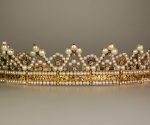Reading Classic Literature for Fun and (Personal) Profit
By Sally Allen
Every day around the world, thousands of people who boast little to no scholarly training in art history walk into museums. Despite this potential absence of knowledge about the proper way to interpret art, visitors are welcomed into these museums. They are, at least tacitly, encouraged to experience the art on the walls. They may, or may not, read discreetly placed placards that share relevant information about artists and works. They may, or may not, avail themselves of complimentary museum literature or buy books in the inevitable gift shop.
Can you imagine if reading said placards, literature, etc. were not a mild-mannered suggestion – “I’ll just put this here, in case (ahem)” – but a requirement? Imagine if, before being permitted to direct their eyeballs to the art on the walls, museum patrons were first ushered into a separate room then invited to read a 15- or 20-page introduction to each piece, or each artist, or even each era. How many people do you suppose would flock to museums if that were the case?
Yet this seems to be the implicit expectation when it comes to reading classic literature.
Classic novels typically come with 15- or 20-page introductions – meaning it should be read before the work itself – by an expert outlining how to read the text, or what the text is about, or what the text means. As Nick Hornby has noted in his Believer magazine columns, these introductions often include spoilers, which seems to assume that readers do not come to classic books to discover, be engrossed in, and be surprised by the story world. Also, apparently, we mustn’t read classics alone, without experts guiding our experiences.
Given this subliminal messaging, it’s impressive that classic literature is read at all, at least outside of school, where it may be required. This is unfortunate because classic literature is in a unique position to show us that we’re not alone in our pains and joys. By taking us out of our time, classic books strip away familiar trappings and references, freeing us to see beyond the ideologies we cling to for identifying “friend” or “enemy” and to connect with core human experiences that endure across time and place. What could be more grounding, more comforting, than seeing ourselves in the battles, longings, and pleasures that have played out across hundreds, thousands, of years of human history?
Hang on, I can imagine some of you saying, looking at visual art isn’t the same as reading literary art. Well, yes, in that art history tends not to be a required school subject, while literature is. What the two have in common, though, is that both can be misread. I might, for example, look at John Singer Sargent’s Portrait of Madame X and think, “Goodness, isn’t she striking?” without knowing the fuller, more fascinating, more controversial story behind the portrait. Jan Van Eyck’s Arnolfini Portrait may move me even before I notice all its exquisite details and rich symbolism. That’s part of the pleasure of experiencing art of all kinds, isn’t it? We discover art objects that speak to us, that we want to spend more time with, and about which we want to learn more. In this way, personal engagement becomes the first step of a longer journey of discovery that deepens our knowledge and understanding of ourselves and our world.
Notice I mentioned nothing about “liking” works of art. We don’t have to “like” them with a Facebook-official thumbs up to be fascinated by and want to learn more about them. Letting go of liking frees us up to enjoy a more complex experience. We may, for example, feel for Hester Prynne from Nathaniel Hawthorne’s The Scarlet Letter though we despair of the world she lived in and the choices she had to make. We don’t necessarily “like” The Scarlet Letter, but we can appreciate and respect it.
And while we’re letting go of things, let’s jettison anxiety about Understanding Everything. We can’t, you know. That means it won’t always be easy, but it will be fun, if we embrace curiosity, the pleasure of unraveling a mystery, and our common bonds as humans. We can feel, for example, the power of self-sacrifice in Charles Dickens’ A Tale of Two Cities even when we lack full understanding of the cultural references and language. We can find inspiration in The Iliad in a Greek and Trojan recognizing each other on the battlefield and refusing to strike each other down, even if we don’t know whether Homer really existed (don’t worry, not even scholars know for certain).
A key to enjoying classic literature, then, isn’t knowing everything but humility. It’s in being willing to linger in not understanding and soldiering on anyway. It’s in recognizing the limits of human knowledge and the absurdity of totalizing judgments. And when a book is over, and we want to learn subtext and context, we can always turn back to the introduction, though perhaps we might prefer to call it an epilogue.
————
Sally Allen is an award-winning author who holds a PhD in English Education from New York University, with an emphasis in writing and rhetoric, and an MA in English Language and Literature. She has taught writing and literature at New York University and Fairfield University, and is the recipient of New York University’s Willy Gorrissen Award for Dedication and Skill in the Academic Development of Student Writing. Currently, Allen is a faculty member at Post University where she teaches literature, writing, and communications. She is the founder of Books, Ink at HamletHub, a website dedicated to Connecticut books news, where her writing has earned her three Connecticut Press Club awards.
Unlocking Worlds (Griffins Wharf, 2015) can be purchased from Amazon and other booksellers nationwide. More information about Sally Allen can be found at www.sallyallenbooks.com, Fa
The post Reading Classic Literature for Fun and (Personal) Profit appeared first on Education News.









Comments are closed.